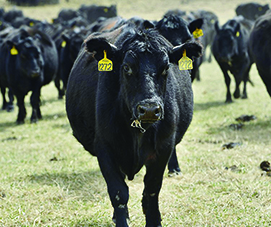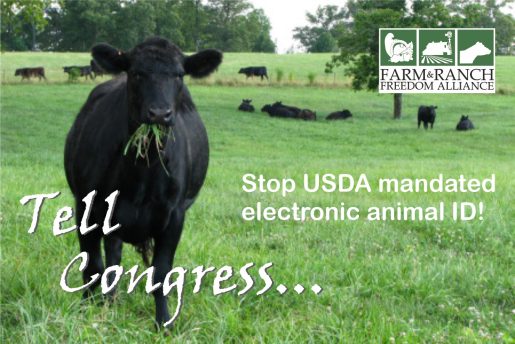The Farm & Ranch Freedom Alliance and a Texas rancher are sounding the cowbell that a proposed federal cattle tagging policy would enrich big cattle producers at the expense of small ranchers.
The U.S. Department of Agriculture (USDA) released its final rule in May, which will take effect in November. The rule mandates electronic ear tags for adult cattle and bison crossing state lines and requires all ear tags to be visually and electronically readable.
Texas rancher Doug Havemann and his wife, Melissa, own and operate Mesquite Field Farm near San Antonio. Havemann sees the newly proposed federal tagging policy as another attempt at the failed National Animal Identification System (NAIS), scrapped in 2010 because of widespread opposition.
In 2010, regulations were criticized for potentially making it hard for ranchers to negotiate fair prices and the plan’s compulsory government inspection mandates.
The new rule amends the 2013 Animal Disease Traceability (ADT) rule, which permitted producers to use a range of ear tags, including less expensive metal tags.
The Animal and Plant Health Inspection Service (APHIS) noted that “it became clear that electronic identification (EID) and records for livestock movement are critical for safeguarding animal health…. In January 2023, APHIS published a proposed rule in the Federal Register and received more than 2,000 comments to consider before publishing the final rule. As a result, USDA is committed to improving an electronic system using EID technology that enables rapid tracing of sick or exposed animals and a rapid response to animal disease,” stated the APHIS.

Havemann told The Dallas Express that major food producers such as Cargill support the policy because it helps them sell product overseas. However, he noted that it does not help if you sell your product “in country,” as he does.

Havemann also revealed that the rule potentially gives an advantage to major food producers who buy most of their cattle from auction barns. Although Havemann does not sell at auction barns because of the thin profit margins, other small farmers do, and they would not be compensated for the EID tags, per Havemann.
Havemann added that a consequence of the rule would be offloading the tagging costs of the major food producers onto the small cattle raisers. Havemann noted that the tags cost $20 a piece, and “you don’t get that tag or expense back [when the cattle are sold].”
“Big boys write that off,” Havemann said, adding, “we don’t.”
However, the Animal and Plant Health Inspection Service (APHIS) noted that “EID tags will be available at no cost to producers through their State Veterinarian’s Offices. EID tags can also be purchased directly from manufacturers and distributors at market rates. …All of the no-cost EID tags are being distributed via the State Veterinarian’s Office in your state. Please contact them.”
The USDA created a list of state veterinarians offering “electronic ID tags at no cost through State Veterinarian Offices.” That list can be found here.
Additionally, APHIS stated that “if your animal has been tagged with a visual-only official identification tag prior to the rule’s effective date, you are not required to apply an electronically readable tag to the animal. All visual-only official identification tags applied to cattle and bison prior to the date the rule is effective will be considered official identification for the lifetime of the animal.”
It is unclear how effectively USDA has promoted the free EID tags to support the new rule.
Havemann had not heard of this program.
Moreover, speaking to DX, McGeary said that the free EID tag program was temporary and could not offset the new rule’s costs permanently.
DX called the Texas Animal Health Commission to ask about the free EID ear tag program. The official who answered the phone confirmed that the program would only last as long as the USDA had dedicated funding. While they had ample supplies, they did not know how long they would last.
“The new rule is nothing more than a cash grab for multinational meatpacking corporations and high-tech companies,” Judith McGeary, executive director of The Farm & Ranch Freedom Alliance (FARFA), said in a September 11 press release.
“These entities are pushing mandatory electronic identification (EID) under the guise of animal health and food safety, but in reality, they are driving up costs and maximizing their own profits. Small farmers and ranchers, already squeezed by food inflation and market pressures, will bear the brunt,” McGeary added.
In contrast, the USDA website hails the merits of the program.
“A comprehensive animal disease traceability system is our best protection against a devastating disease outbreak,” a USDA statement stated, “USDA is committed to implementing a modern system that tracks animals from birth to slaughter using affordable technology that allows for quick tracing of sick and exposed animals to stop disease spread.”
“Although animal disease traceability does not prevent disease, an efficient and accurate traceability system reduces the number of animals and response time involved in a disease investigation. This, in turn, reduces the economic impact on owners and affected communities,” continued the statement by USDA.
McGeary raised another objection. Pointing to FARFA’s recent letter to Congress, McGeary argued the rule was illogical.
“The USDA claims that people reading and hand-transcribing tags is causing problems — yet the new mandate is for tags that are both electronically and visually readable. So that means that, for now, farmers can attach these (temporarily free) tags to their cattle and keep writing down the numbers by hand, which does nothing to address the supposed problem,” said McGeary.
McGeary followed up by forecasting what FARFA sees as the incoming dangers of this program.
“Why did the USDA adopt such a useless rule and then spend millions on the electronic tags,” McGeary asked rhetorically, “Because that allowed the agency to avoid addressing the full costs of an electronic tagging system, which would include readers, software, computers, and reliable internet service in order to electronically read the tags and get that information into electronic documents. So the agency will inevitably adopt another rule, requiring the full electronic system — and the costs of that are many times the costs of just the tags,” she said.
On top of allegedly being expensive and illogical, the press release argued that the program would be ineffective.

“Critics argue that the USDA’s new requirement disregards the effectiveness of the current system, which has already enabled cattle tracing within an average of one hour. Instead, the rule introduces higher costs for electronic tags while retaining the need for manual recordkeeping,” per FARFA’s news release.
FARFA’s efforts to fight the rule have been joined by 46 other agriculture and livestock organizations.
“The USDA’s move to mandate both electronic and visual tags is clearly a stepping stone towards a more expensive, fully electronic system,” Antonio Tovar, National Family Farm Coalition’s Senior Policy Associate, said. “Producers will end up paying more for tags while still having to transcribe numbers by hand. It’s evident that the USDA plans to transition to a costly all-electronic system, leaving farmers and ranchers footing the bill.”
Echoing this statement, Joe Maxwell of Farm Action Fund stated, “This rule is a blatant attempt to side with big meatpackers over independent farmers and ranchers. The USDA’s actions are picking winners and losers, with small producers paying the price for a system that benefits only the largest players in the industry.”
Alexia Kulwiec of the Farm-to-Consumer Legal Defense Fund concurred. “The USDA’s mandatory electronic ear tag rule disproportionately benefits large meatpackers by allowing them to avoid the requirements through group identification. In contrast, it imposes significant costs, burdens, and risks on independent ranchers and farmers. There is no evidence that RFID tags are necessary for effective disease traceability,” he said.


